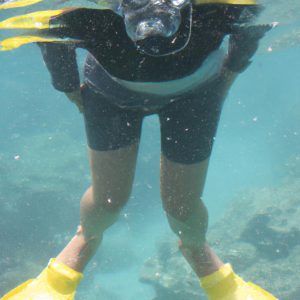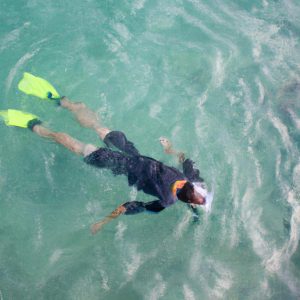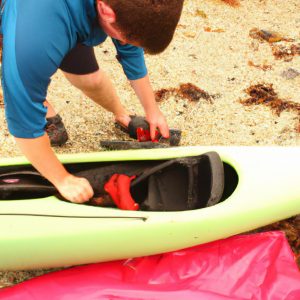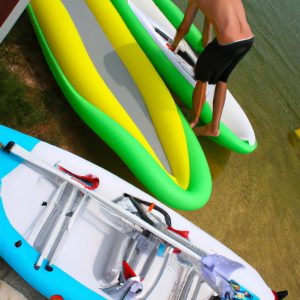Water Sports: Safety Tips for Snorkeling
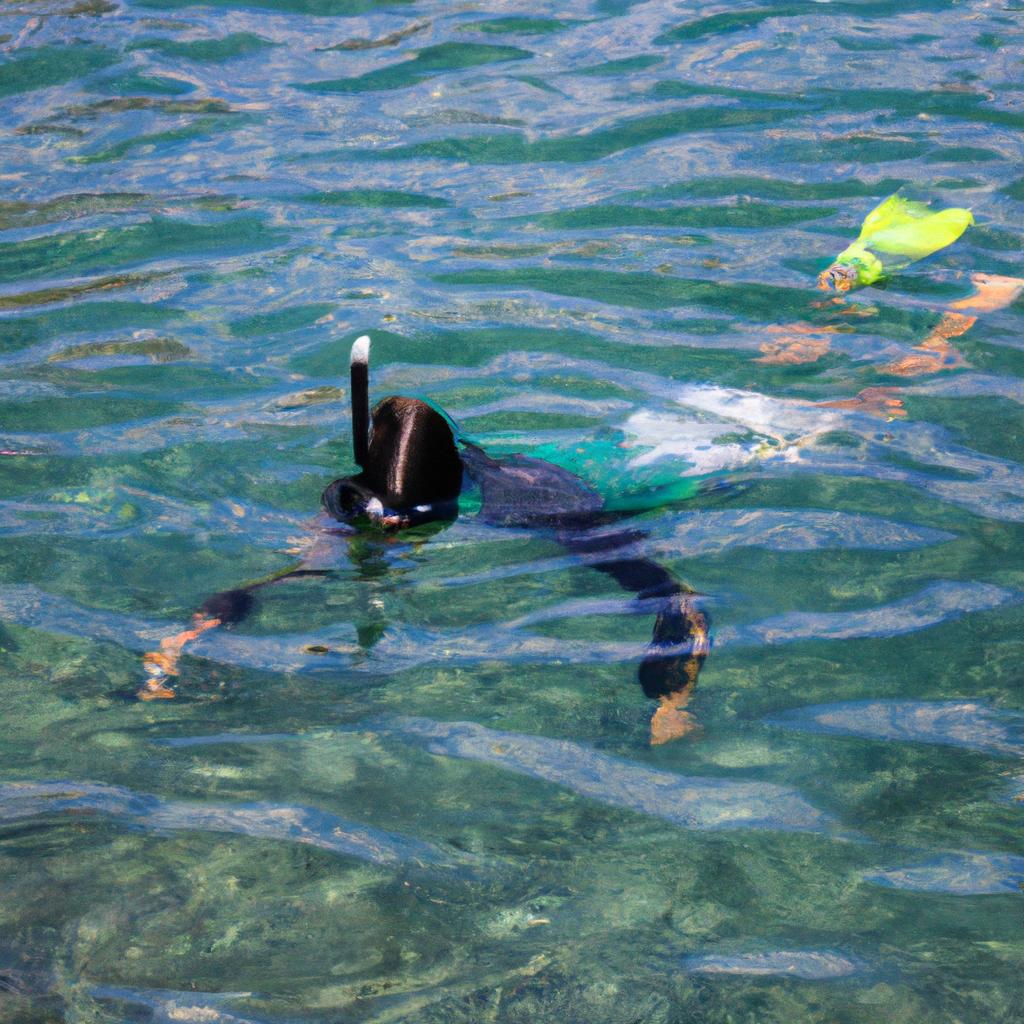
Water sports such as snorkeling offer individuals the opportunity to explore the captivating underwater world and its diverse ecosystem. However, like any other outdoor activity, snorkeling carries inherent risks that should not be overlooked. Understanding and implementing safety measures is crucial for ensuring an enjoyable and incident-free experience in the water. This article aims to provide valuable insights into essential safety tips for snorkeling, drawing upon real-life examples to underscore the importance of adhering to these precautions.
Imagine a scenario where a novice snorkeler excitedly plunges into the crystal-clear waters of a tropical reef. Enchanted by the vibrant colors and graceful movements of marine life, this individual becomes so engrossed in their surroundings that they fail to notice their diving partner being carried away by a strong current. The lack of awareness regarding basic safety guidelines could potentially lead to serious consequences. Therefore, it is paramount for all snorkelers, regardless of their skill level or familiarity with aquatic environments, to equip themselves with adequate knowledge on how to mitigate potential hazards while enjoying this popular recreational activity.
By following proper safety protocols during snorkeling excursions, enthusiasts can safeguard themselves from various dangers lurking beneath the water’s surface. Familiarizing oneself with essential equipment such as well-fitted masks, fins, and snorkels is the first step towards ensuring a safe and comfortable snorkeling experience. Ill-fitting gear can cause discomfort, hinder visibility, and increase the risk of accidents. It is crucial to choose equipment that fits snugly but not too tight, allowing for easy breathing and unobstructed vision.
Before venturing into the water, it is essential to assess weather conditions and be aware of any potential hazards such as strong currents or rough waves. Snorkelers should avoid snorkeling in areas with high surf or poor visibility, as these conditions can make it difficult to navigate or spot potential dangers.
Furthermore, knowledge of one’s own physical limitations is vital. Snorkelers should be mindful of their fitness level and swimming abilities before embarking on a snorkeling adventure. If unsure about their capabilities, it is advisable to seek professional guidance or participate in lessons or training sessions to improve skills and build confidence in the water.
Buddy systems are an integral part of snorkeling safety. Having a dive buddy allows for mutual support and assistance in case of emergencies. Before entering the water, buddies should establish clear communication signals and agree upon a plan in case they become separated underwater.
Additionally, maintaining proper buoyancy control while snorkeling helps conserve energy and reduces the risk of accidental contact with fragile coral reefs or marine life. Snorkelers should strive to float effortlessly without touching the seabed or disturbing underwater habitats.
Awareness of marine life behavior is crucial for both personal safety and environmental conservation. While it may be tempting to touch or approach marine creatures, it is important to remember that these animals are wild and should be observed from a respectful distance. Touching coral reefs or other organisms can cause harm to both the wildlife and oneself due to stings, bites, or other defensive mechanisms.
Finally, being prepared for emergencies is essential when engaging in any water-based activity. Carrying safety equipment such as signaling devices (such as a whistle), a first aid kit, and knowing basic rescue techniques can make a significant difference in critical situations.
In conclusion, snorkeling is an incredible way to explore the beauty of the underwater world. However, it is crucial to prioritize safety by following essential guidelines such as using proper equipment, assessing environmental conditions, understanding personal limitations, practicing buoyancy control, utilizing buddy systems, respecting marine life, and being prepared for emergencies. By adhering to these safety measures, snorkelers can enjoy their experience while minimizing risks and ensuring their own well-being and that of the marine environment they are privileged to witness.
Choosing the right equipment
Choosing the Right Equipment
Imagine this scenario: you are excited about your upcoming snorkeling adventure in a beautiful tropical destination. As you arrive at the dive shop, you are overwhelmed by the array of equipment options available to you. How do you know which gear is right for you? In this section, we will explore some key considerations when choosing the appropriate snorkeling equipment.
First and foremost, it is essential to select a well-fitting mask that provides a watertight seal around your face. A poorly fitting mask can lead to discomfort, leakage, and impaired vision underwater. To ensure an optimal fit, try on different masks and adjust the straps accordingly. Additionally, consider factors such as lens shape and material to suit your personal preferences.
Secondly, selecting the right pair of fins is crucial for efficient movement through the water. Fins provide propulsion and enhance maneuverability while allowing you to conserve energy during extended periods of swimming. When choosing fins, opt for ones that fit snugly but not too tight, with adjustable straps that securely hold them in place.
Furthermore, investing in a high-quality snorkel can greatly enhance your overall experience. Look for features like a comfortable mouthpiece made from hypoallergenic materials and purge valves for effortless clearing of any water that enters the tube. It is also recommended to choose one with a splash guard or dry-top valve design to prevent water from entering when waves splash over.
To summarize:
- Choose a well-fitting mask.
- Select fins that provide efficient propulsion.
- Invest in a quality snorkel with convenient features.
- Opt for additional accessories like neoprene socks or gloves if desired.
By carefully considering these aspects when selecting your snorkeling equipment, you can ensure maximum comfort and enjoyment throughout your underwater exploration.
Now let’s move on to our next section where we’ll discuss how checking weather conditions before snorkeling is vital for safety…
Checking weather conditions
Safety is paramount when it comes to enjoying water sports like snorkeling. In the previous section, we discussed the importance of choosing the right equipment for a safe snorkeling experience. Now, let’s delve into another crucial aspect: checking weather conditions before heading out.
Imagine this scenario: you have planned a snorkeling trip with your friends and arrive at the beach excitedly. However, upon reaching there, you notice dark clouds gathering in the distance and strong winds picking up. Ignoring these warning signs could put you in danger during your underwater adventure.
To ensure your safety while snorkeling, always check the weather conditions beforehand. Here are some key points to consider:
- Monitor local weather forecasts or consult with lifeguards to obtain accurate information.
- Be aware of any storm warnings or potential changes in weather patterns that may impact sea conditions.
- Pay attention to wind speed and direction as strong gusts can create dangerous currents.
- Take note of tidal movements as they can affect visibility and current strength.
- Avoiding hazardous situations by staying updated on changing weather patterns.
- Ensuring personal safety through responsible decision-making.
- Minimizing risks associated with unpredictable oceanic conditions.
- Preventing accidents and injuries caused by adverse weather effects.
Additionally, incorporating a table showcasing different types of extreme weather conditions and their potential hazards can evoke an emotional response from readers:
| Weather Condition | Potential Hazards |
|---|---|
| Thunderstorms | Lightning strikes, rough waters |
| Heavy rainfall | Reduced visibility, flash floods |
| High winds | Dangerous currents, difficult swimming |
| Tropical storms | Strong waves, powerful surges |
In conclusion, prior knowledge of prevailing weather conditions is vital for ensuring a safe snorkeling experience. By staying informed about any potential dangers such as storms, heavy rain, high winds, or tropical disturbances, you can make responsible decisions and protect yourself from harm. Now let’s move on to the next section about understanding snorkeling signals as we continue exploring essential safety tips for snorkeling adventures.
Understanding snorkeling signals
Weather conditions play a crucial role in ensuring the safety of snorkelers. By carefully checking weather forecasts before embarking on a snorkeling adventure, you can avoid potentially dangerous situations and enjoy your experience to the fullest.
For instance, imagine planning a snorkeling trip in an area known for sudden weather changes. Failing to check the weather beforehand could result in unexpectedly strong currents or storms that put your safety at risk. However, by staying informed about upcoming weather patterns and heeding any warnings or advisories issued by local authorities, you can make informed decisions about whether it is safe to proceed with your plans.
To further emphasize the importance of checking weather conditions before snorkeling, consider the following emotional bullet points:
- Protect yourself and others from potential harm
- Ensure a worry-free and enjoyable experience
- Minimize the risk of accidents or emergencies
- Preserve natural marine environments through responsible behavior
In addition to keeping an eye on the forecast, it is essential to understand common snorkeling signals used among divers. These signals allow for effective communication underwater and ensure everyone’s safety.
Here is an example table outlining some commonly used snorkeling signals:
| Signal | Meaning |
|---|---|
| Hand pointing upwards | Ascend slowly |
| Hand waving side to side | Stop or halt |
| Thumb up | I’m okay |
| Fist closed | Problem or distress |
By familiarizing yourself with these signals and being aware of their meanings, you can effectively communicate with fellow snorkelers while exploring underwater wonders.
Transitioning smoothly into the subsequent section about “Staying hydrated,” remember that maintaining proper hydration is essential during any physical activity – including snorkeling.
Staying hydrated
Understanding snorkeling signals is crucial for ensuring safety while enjoying this water sport. By knowing and recognizing these signals, snorkelers can effectively communicate with their buddies or dive masters underwater, allowing for a smoother and safer experience.
For instance, imagine you are on a snorkeling trip in the Caribbean, exploring vibrant coral reefs teeming with marine life. Suddenly, you spot something fascinating—a sea turtle gliding gracefully through the clear blue waters. Excitedly, you want to share this memorable encounter with your buddy. However, without understanding snorkeling signals, conveying your excitement would be challenging.
To help ensure effective communication underwater, here are some essential snorkeling signals:
- The “OK” signal: Forming an “O” shape with your thumb and index finger indicates that everything is fine.
- The “Stop” signal: Extending one arm straight out in front of you and placing the palm flat against the other hand signifies the need to halt any movement.
- The “Ascend/Descend” signal: Raising or lowering one arm slowly implies ascending or descending respectively.
- The “Help Me!” signal: Waving both arms above your head urgently communicates distress and the need for assistance.
By familiarizing yourself with these snorkeling signals before embarking on your next aquatic adventure, you will enhance safety measures and enjoy a more secure exploration beneath the surface.
Now let’s turn our attention to another vital aspect of staying safe while engaging in water sports—staying hydrated.
| Snorkeling Signals | Meaning |
|---|---|
| OK | Everything is fine |
| Stop | Halt any movement |
| Ascend/Descend | Signal to ascend/descend |
| Help Me! | Indication of distress |
In conclusion, understanding snorkeling signals allows for effective communication between divers underwater. Whether it’s indicating well-being, requesting assistance, or signaling a pause in movement, these signals are essential for maintaining safety in the water. By familiarizing yourself with these gestures, you can enhance your snorkeling experience and ensure a safer adventure.
Next section: Avoiding contact with marine life
Avoiding contact with marine life
Water Sports: Safety Tips for Snorkeling
Staying hydrated is crucial when engaging in water sports activities such as snorkeling, as it helps maintain physical performance and prevents dehydration. In fact, a lack of proper hydration can lead to fatigue, dizziness, and even fainting while underwater. To illustrate the importance of staying hydrated during snorkeling excursions, consider the following scenario:
Imagine you are on a tropical vacation and decide to go on a guided snorkeling tour. The day is hot and sunny, making it essential to drink enough fluids before entering the water. However, one individual in your group neglects this important step and fails to hydrate adequately.
To ensure your safety while snorkeling, here are some key tips to follow:
- Drink plenty of water before heading into the water.
- Avoid consuming alcohol or caffeine prior to snorkeling.
- Bring a reusable water bottle with you to stay hydrated throughout the activity.
- If possible, choose shaded areas during breaks from snorkeling to prevent excessive sun exposure.
By adhering to these guidelines, you can minimize the risk of dehydration and enjoy a safer snorkeling experience.
Below is an emotional bullet point list highlighting the potential dangers of inadequate hydration during snorkeling:
- Dehydration increases the likelihood of muscle cramps.
- Lack of fluids impairs cognitive function and decision-making abilities.
- Fatigue caused by insufficient hydration may reduce swimming efficiency.
- Severe dehydration can result in heatstroke or other life-threatening conditions.
Moreover, take note of these useful reminders presented in a table format:
| Hydration Tips for Snorkelers |
|---|
| 1. Drink at least 16 ounces (500 ml) of fluid two hours before snorkeling. |
| 2. Limit intake of sugary beverages that may cause thirst-inducing effects. |
| 3. Aim to consume approximately 8 ounces (250 ml) of water every hour during snorkeling. |
| 4. Consider bringing a sports drink to replenish electrolytes lost through sweating and exertion. |
In summary, maintaining proper hydration is vital for an enjoyable and safe snorkeling experience. By following the suggested tips, you can reduce the risk of dehydration-related complications while exploring the underwater world.
Transitioning into the next section about “Knowing your limits,” it’s crucial to understand how pushing oneself beyond their capabilities can lead to potential dangers in water sports activities such as snorkeling.
Knowing your limits
While it is important to avoid contact with marine life during snorkeling, knowing your limits in the water is equally crucial. This section will discuss key factors that can help you recognize and respect your boundaries while engaging in this exhilarating activity.
Knowing Your Limits:
Understanding how far you can push yourself underwater without compromising safety is essential to ensure an enjoyable snorkeling experience. Let’s consider a hypothetical scenario to illustrate this point. Imagine you are exploring a vibrant coral reef teeming with colorful fish and fascinating marine creatures. Excitement builds as you venture deeper into the ocean, encountering mesmerizing sights at every turn. However, suddenly you realize that fatigue sets in, causing discomfort and making it challenging to swim back to shore. In such situations, being aware of your limitations becomes vital for preventing potential dangers.
To assist you further in assessing your capabilities while snorkeling, here are some points worth considering:
- Physical Fitness: Ensure you have sufficient stamina and physical fitness levels before embarking on a snorkeling adventure.
- Equipment Familiarity: Be well-acquainted with your gear and its functionality beforehand.
- Environmental Factors: Take note of any adverse conditions such as strong currents or rough waves that may affect your swimming ability.
- Duration of Activity: Plan your snorkeling excursion based on the duration suitable for your comfort level.
Here are four tips to help gauge your limits effectively:
- Listen to your body – pay attention to signs of exhaustion or distress.
- Communicate with fellow snorkelers and always inform someone about your planned activities.
- Gradually increase depth and distance over time rather than attempting advanced techniques right away.
- Seek guidance from experienced instructors who can provide valuable insights into recognizing personal thresholds.
Markdown table:
| Factors Affecting Limitations | Signs Indicating Limitations | Precautionary Measures |
|---|---|---|
| Physical fitness level | Fatigue, shortness of breath | Engage in regular exercise routines to improve endurance. |
| Equipment familiarity | Difficulty breathing due to improper mask fitting | Ensure proper adjustment and fit of snorkeling gear before entering the water. |
| Environmental conditions | Struggling against strong currents or waves | Check weather forecasts and ocean conditions prior to snorkeling. |
| Duration of activity | Feeling overwhelmed or uncomfortable after extended periods underwater | Begin with shorter intervals, gradually increasing duration over time. |
Recognizing your limits is crucial for maintaining personal safety during snorkeling excursions. By understanding how physical fitness, equipment familiarity, environmental factors, and activity duration can impact your capabilities, you can make informed decisions that enhance both enjoyment and security while exploring the wonders beneath the surface.
Note: It is important to remember that these guidelines are intended as general advice. Each individual’s abilities may differ, so it is essential to assess one’s own comfort levels and consult professionals when necessary.

